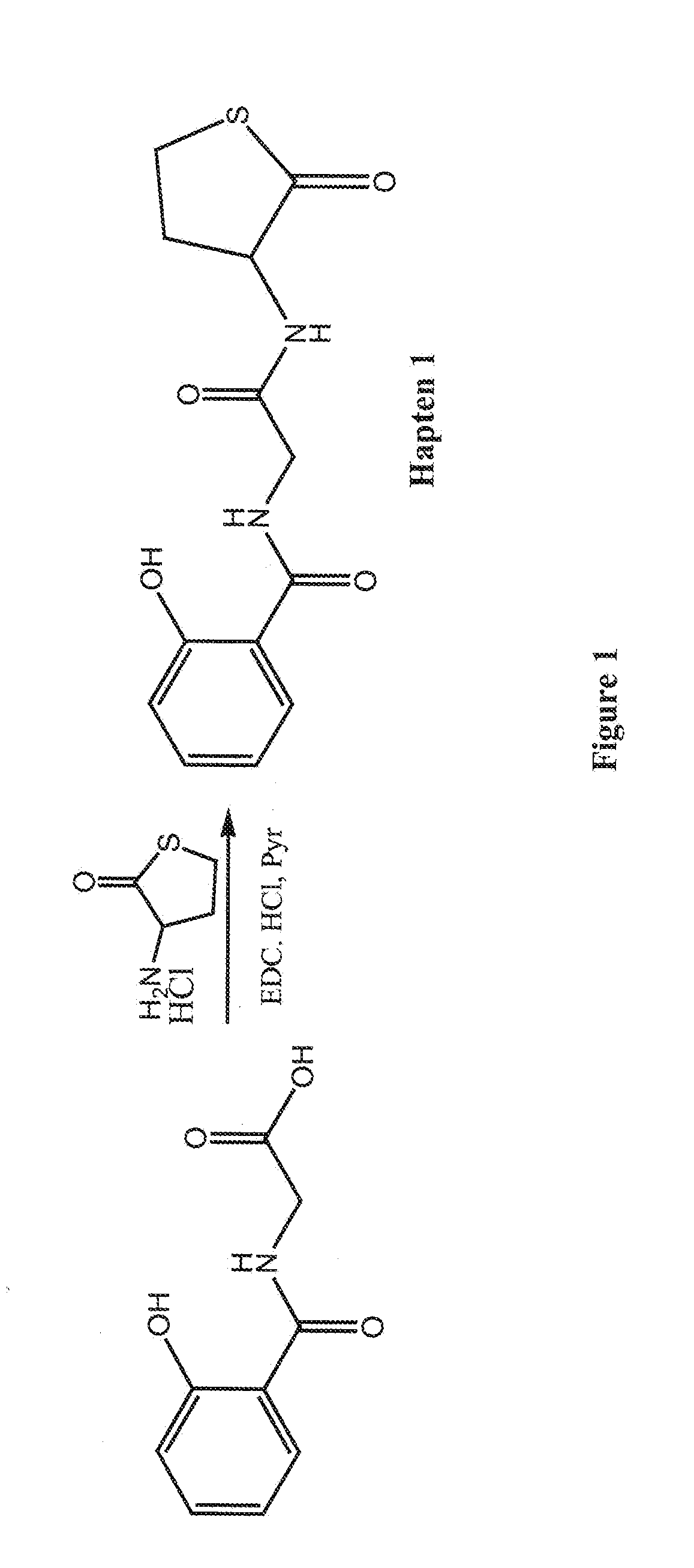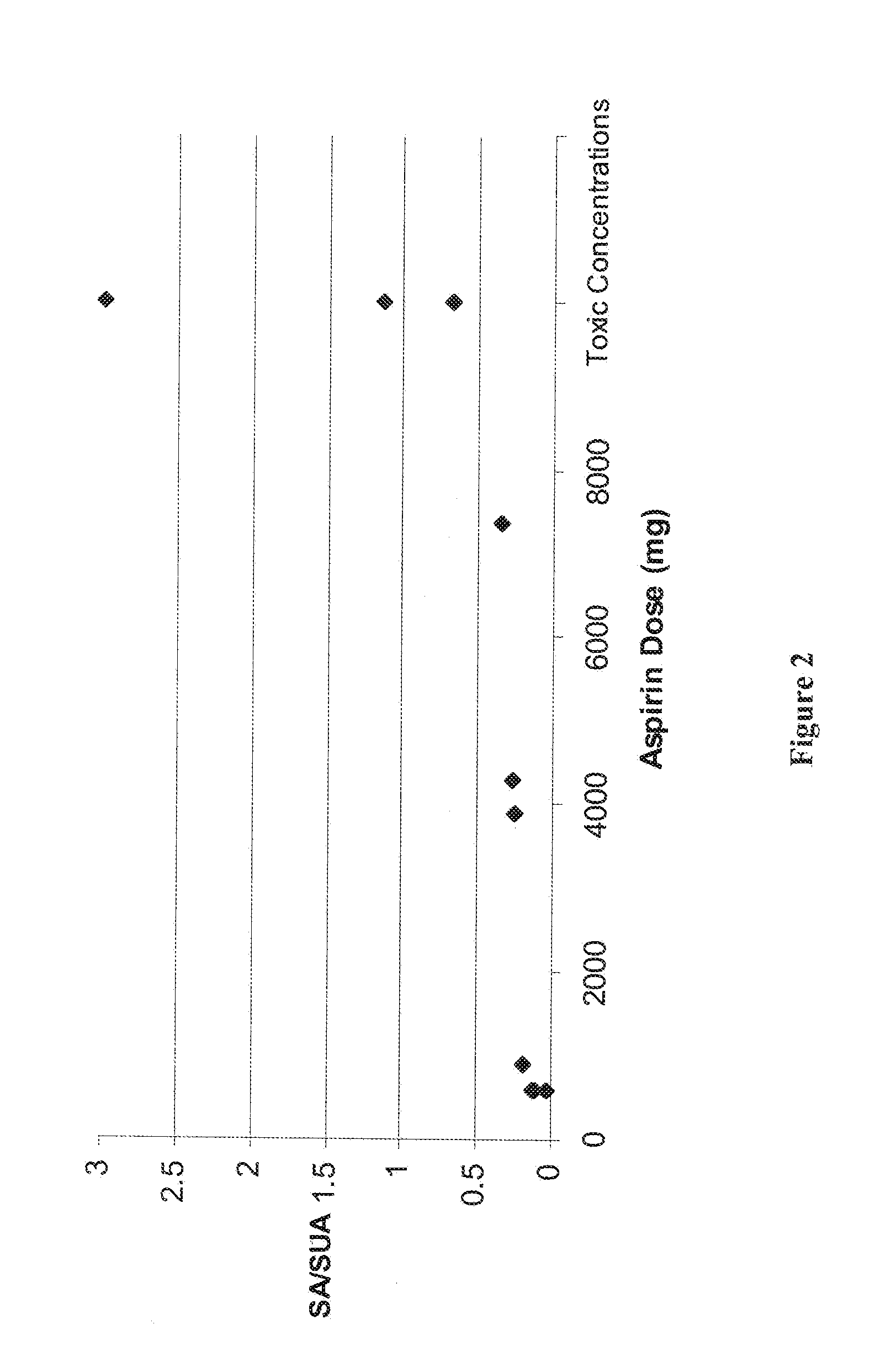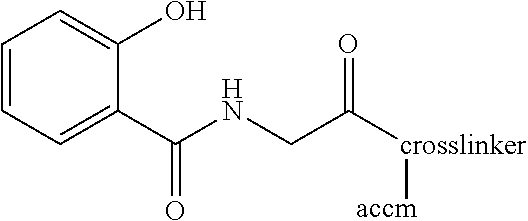Aspirin assay
a technology of aspirin and aspirin, which is applied in the field of aspirin assay, can solve the problems of increasing the level of aspirin that may be exceeding the optimum therapeutic level and becoming toxic, and achieves the effects of less invasiveness, avoiding the possibility of errors, and maintaining the optimum level of aspirin
- Summary
- Abstract
- Description
- Claims
- Application Information
AI Technical Summary
Benefits of technology
Problems solved by technology
Method used
Image
Examples
example 1
Conjugation of Salicyluric Acid to BSA
[0038]To a solution of salicyluric acid (22.05 mg, 0.113 mM) in DMF (1.0 ml) was added N,N-dicyclohexylcarbodiimide (DCC) (25.58 mg, 0.124 mM) and N-hydroxysuccinimide (NHS) (14.27 mg, 0.124 mM) and the mixture was stirred at room temperature overnight. The dicyclohexylurea formed was filtered and the solution obtained was added dropwise to a solution of BSA (150 mg, 2.3 82 M) in sodium bicarbonate solution (100 mM, 10 ml) pH 8.5 and the solution was incubated overnight at room temperature. The solution was then dialysed against 50 mM phosphate buffer pH 7.2 (3 changes) for 24 hours at 4° C., and freeze-dried. MALDI results showed 17 molecules of salicyluric acid had been conjugated to one molecule of BSA.
example 2
Conjugation of Salicyluric Acid to BTG
[0039]To a solution of salicyluric acid (26.34 mg, 0.135 mM) in DMF (1.0 ml) was added N,N-dicyclohexylcarbodiimide (DCC) (30.53 mg, 0.148 mM) and N-hydroxysuccinimide (NHS) (17.03 mg, 0.148 mM) and the mixture was stirred at room temperature overnight. The dicyclohexylurea formed was filtered and the solution obtained was added dropwise to a solution of BTG (150 mg) in sodium bicarbonate solution (100 mM, 10 ml) pH 8.5 and the solution was incubated overnight at room temperature. The solution was then dialysed against 50 mM phosphate buffer pH 7.2 (3 changes) for 24 hours at 4° C., and freeze-dried.
example 3
Preparation of Antisera
[0040]In order to generate polyclonal antisera, the immunogen (prepared in Example 2) was mixed with primary complete Freund's Adjuvant (Sigma) and injected into a host sheep to provide target-specific polyclonal antisera. On a monthly basis the immunogen (with incomplete Freund's Adjuvant) was injected into the sheep. The host animal was bled to yield a suitable volume of specific antiserum. IgG was then extracted from the antisera via Caprylic acid / ammonium sulphate precipitation of immunoglobulin.
PUM
| Property | Measurement | Unit |
|---|---|---|
| concentration | aaaaa | aaaaa |
| concentrations | aaaaa | aaaaa |
| pH | aaaaa | aaaaa |
Abstract
Description
Claims
Application Information
 Login to View More
Login to View More - R&D
- Intellectual Property
- Life Sciences
- Materials
- Tech Scout
- Unparalleled Data Quality
- Higher Quality Content
- 60% Fewer Hallucinations
Browse by: Latest US Patents, China's latest patents, Technical Efficacy Thesaurus, Application Domain, Technology Topic, Popular Technical Reports.
© 2025 PatSnap. All rights reserved.Legal|Privacy policy|Modern Slavery Act Transparency Statement|Sitemap|About US| Contact US: help@patsnap.com



